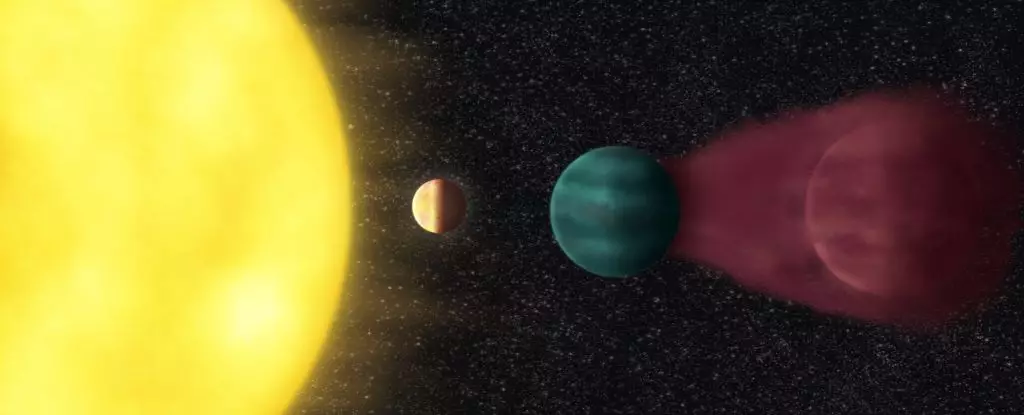The discovery of exoplanet HD 63433 d, located a mere 73 light-years away, has provided scientists with a captivating insight into what our baby Earth might have resembled if it had been situated in a scorchingly tight orbit around its star. HD 63433 d is exceptionally similar to our own world, as it is a newborn exoplanet slightly larger than Earth, orbiting a star identical to the Sun. However, what makes this finding particularly striking is the fact that it is the smallest planet we have identified that is less than 500 million years old. This offers a rare opportunity for scientists to study the formation and evolutionary processes of planets that bear some resemblance, albeit not entirely, to our home planet.
As Earth is the only known planet to harbor life, understanding the various ways in which Earth-like planets can form and evolve, particularly around Sun-like stars, is crucial for determining the necessary ingredients for life to arise elsewhere in the vast Universe. The unique characteristics of HD 63433 d make it an invaluable celestial body for scientific investigation. Astrophysicist Melinda Soares-Furtado of the University of Wisconsin-Madison, who co-led the research with astronomer Benjamin Capistrant of the University of Florida, explains that despite its proximity to its star, researchers can utilize follow-up data to search for evidence of outgassing and atmospheric loss, providing essential insights into the development of terrestrial worlds. Nevertheless, it is important to note that HD 63433 d diverges dramatically from Earth in several exciting ways.
HD 63433 d was discovered during a survey conducted using the TESS exoplanet-hunting telescope, which monitors stars for faint, regular declines in starlight that indicate the presence of an orbiting exoplanet. By analyzing the various effects that the exoplanet has on the star’s light, astronomers can determine its size and mass. The star hosting HD 63433 d, known as HD 63433, is a yellow dwarf star that boasts a size and mass similar to that of the Sun, along with a comparable temperature profile. However, the star is much younger, with an age of just over 400 million years compared to the Sun’s 4.5 billion years.
To date, scientists have identified three exoplanets around HD 63433: two mini-Neptunes observed in 2020, and the remarkable HD 63433 d. Transit data, obtained from the dips in starlight as the exoplanet orbits, reveal that HD 63433 d has a radius 1.1 times that of Earth, suggesting a terrestrial composition akin to rocky bodies such as Earth, Mars, or Venus. Due to its tight orbit, taking only 4.2 days to complete, HD 63433 d and its star are in extremely close proximity. Consequently, the exoplanet is likely tidally locked, with one side perpetually facing the star. Researchers believe that the hemisphere facing the star experiences scorching temperatures, transforming its surface into a permanent sea of molten rock. Estimates indicate a searing dayside temperature of 1,570 Kelvin (1,297 Celsius or 2,366 Fahrenheit), effectively likening HD 63433 d to a colossal ocean of lava.
While Earth has never experienced such proximity to the Sun, it did encounter temperatures as high as 2,300 Kelvin following the collision that led to the formation of the Moon. However, numerous details regarding HD 63433 d remain unidentified. The research team anticipates that further investigations will yield additional insights, including its mass. This crucial information will allow scientists to calculate HD 63433 d’s density, which, in turn, provides clues about its composition. Additionally, scientists hope to ascertain whether the exoplanet possesses an atmosphere and, if so, its composition. Soares-Furtado highlights the importance of this discovery, emphasizing that HD 63433 d resides within our solar backyard. Consequently, it raises exciting questions regarding the wealth of knowledge a star in such close proximity, with a crowded system, can bestow upon us. Such inquiries will guide future investigations into the approximately 100 similar stars within the young group to which HD 63433 belongs.
HD 63433 d represents a captivating finding that offers a rare opportunity for scientists to delve into the early stages of Earth-like planet formation. As research into this exoplanet progresses, exciting discoveries lie ahead. HD 63433 d’s proximity and intriguing characteristics make it an enticing subject of study. The information gleaned from this celestial body will contribute invaluable insights as we explore the possibility of life beyond our own planet.



Leave a Reply